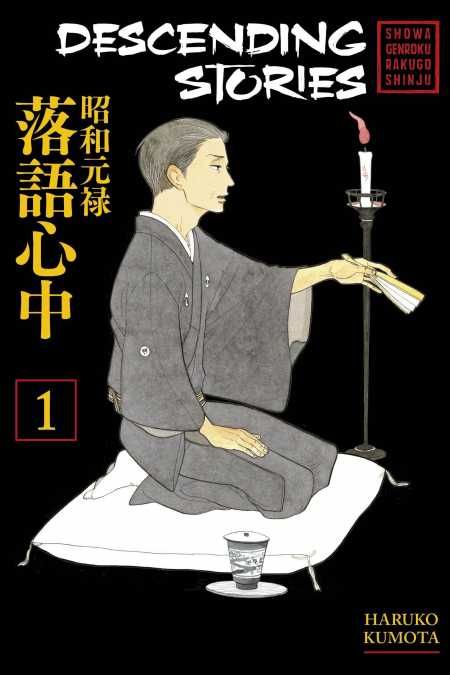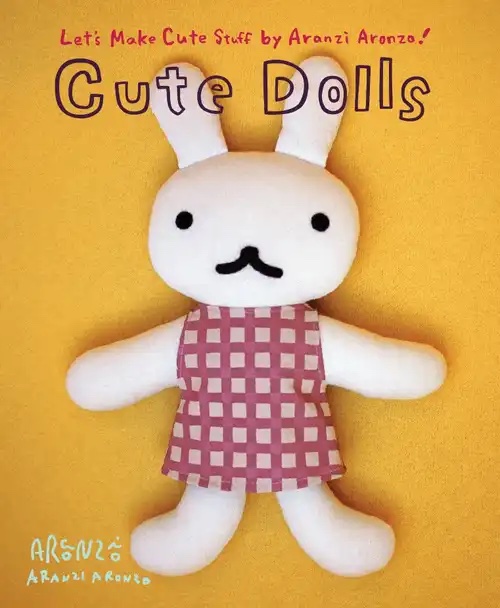In the opening pages of Descending Stories, we’re introduced to Yotaro, an amiable ex-con with an unusual plan for going straight: he wants to become a rakugoka, or rakugo artist. To learn the ropes of this venerable performing tradition, Yotaro cajoles Yakumo, a rakugo master, into accepting him as an apprentice — something that Yakumo has resisted doing in the past, even when more suitable candidates have presented themselves. Descending Stories then follows Yotaro’s first clumsy efforts at telling stories, making people laugh, and resisting the temptations of his old life.
Rakugo, for the uninitiated, is Japan’s answer to continuous vaudeville. In lieu of acrobats and jugglers, however, yose (venues) offer customers a steady flow of rakugokas who regale the audience with humorous stories, each adhering to a clearly defined format that begins with the makura (prelude), moves to the hondai (main story), and concludes with the ochi (punchline). Unlike a vaudeville artist — or a manzai duo, for that matter — the rakugoka remains seated while delivering his material, using only two simple props — a fan and a cloth — to convey what’s happening.
In theory, rakugo sounds like an ideal topic for a manga: it’s a storytelling genre that relies almost exclusively on facial expressions and physical gestures to bring the story to life, actions that translate well to a silent, static medium like comics. The audible dimension of a rakugo performance also lends itself to graphic depiction, as a well-chosen typeface can suggest the register, volume, gender, and age of the person speaking. Yet the rakugo performances in Descending Stories capture little of the magic that would explain the genre’s enduring appeal in Japan. Too often, Haruko Kumota cross-cuts between a snippet of performance and a snippet of conversation in which audience members praise the rakugoka‘s technique, or comment on how much everyone else seems to be enjoying themselves. The net result feels more like watching a football game on television than attending a theatrical performance; we can see what’s happening, but the relentless stream of chatter and clumsy framing of the action keep us at arm’s length.
The flatness of these performances stand in sharp contrast to the vibrant story that surrounds them. Though the principal cast is small — Yotaro, Yakumo, and Konatsu, Yakumo’s adopted daughter — Kumota squeezes plenty of dramatic juice out of their interactions. In chapter three, for example, Konatsu accuses Yakumo of murdering her biological father, Sukeroku, who was also an accomplished performer. She vows to exact revenge by taking up rakugo herself, a gesture designed to provoke the staunchly traditionalist Yakumo. “Women can’t perform rakugo,” he tells her:
That’s just the way it is. They can’t enjoy stupidity, for one thing. Even if they can, their art doesn’t deepen as they age. And should they somehow master the art… well, there’s nothing more unpleasant than a woman who can do a good impression of a man. There’s just too much to overcome.
Yet Yakumo is no soap opera villain, intent on crushing the spirit of a plucky heroine; he’s a realist who bears deep — and as yet unrevealed — wounds from collaborating with Konatsu’s dad. He recognizes the depth of Konatsu’s pain, and her sincere desire to preserve her father’s legacy by memorizing and performing his material. As a conciliatory gesture, Yakumo begins reciting “The Naughty Three,” one of Sukeroku’s stories. This eight-panel sequence offers a fleeting glimpse of Yakumo’s true artistry, showing us how he twists his face and bends his torso to portray the story’s main characters. Only a solitary panel of Konatsu sobbing, “My father… He’s alive,” undercuts the effectiveness of the scene, baldly stating what’s apparent from the illustrations.
And that, in a nutshell, is what makes Descending Stories simultaneously frustrating and compelling. On the one hand, Kumota tries so hard to persuade us that rakugo is a funny, spellbinding, and vital tradition that the performances never take flight on the page; even the best scenes are marred by comments that feel like a poke in the ribs: “Didja get it?” On the other hand, Kumota creates such passionate, complex characters that it’s fundamentally impossible to dislike Descending Stories; I want to know whether Yotaro becomes a rakugoka, or if Konatsu finds an outlet for her own storytelling gift. My suggestion: read the omake for insights into rakugo, and read the main chapters for the drama.
DESCENDING STORIES: SHOWA GENROKU RAKUGO SHINJO, VOL. 1 • BY HARUKA KUMOTA • KODANSHA COMICS • RATING: YOUNG ADULT (13+)




Aaron says:
The Anime was great but without spoiling it don’t watch the last episode of season two. The implications of one of the plot twists actually made me cancel all my pre-orders for the series.
Katherine Dacey says:
Thanks for the tip, Aaron!
Aaron says:
Yeah I don’t want to spoil it for anyone partially because “misery loves company”. Also part of me want’s to maliciously enjoy that feeling of despair when the sickening realization sinks in about what just happened with the ending. In short this series is one of those rare beasts in fiction that retroactively ruins it’s self with it’s ending.
The only other series I can think of that did this off the top of my head in Anime and Manga is OreImo and in Western Comics Identity Crisis or as a writer at Comics Alliance called it “the comic book that kills comics.” Either way the evil side of me is going to have a blast when volume 10 drops.
Of course the reverse can happen to I hated Scum’s Wish Anime adaptation but the ending gave me an ending in a “romance” Anime or Manga I’d been clamoring for, for years it’s still not good but I can at least begrudgingly respect it. Anyways forewarned is forarmed
Anna says:
Bought its first volume because I really love the anime adaptation of this manga. The anime clearly shows the emotion and the art of Rakugo and how fragile the art is in this modern society. Now regarding about the comment of Aaron, it depends on what the viewers will think as they finished watching the last two episodes of the 2nd season, even I was intrigued and confused about it. But Kumota-sensei released an extra chapter about it.